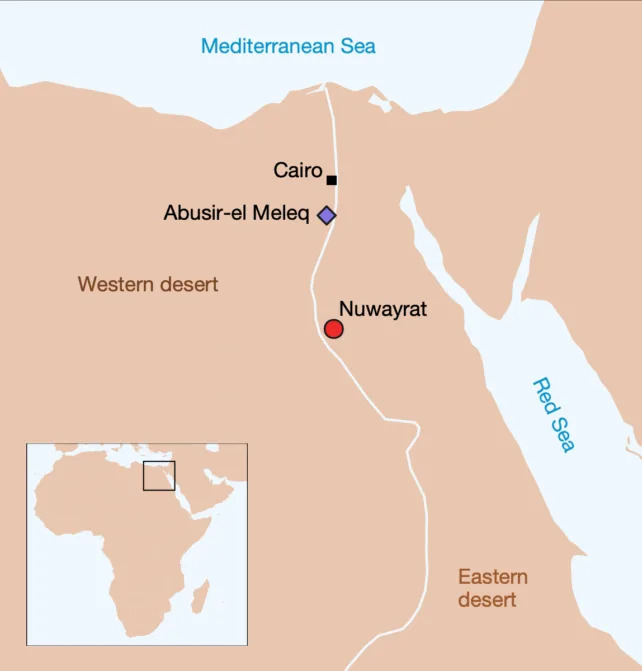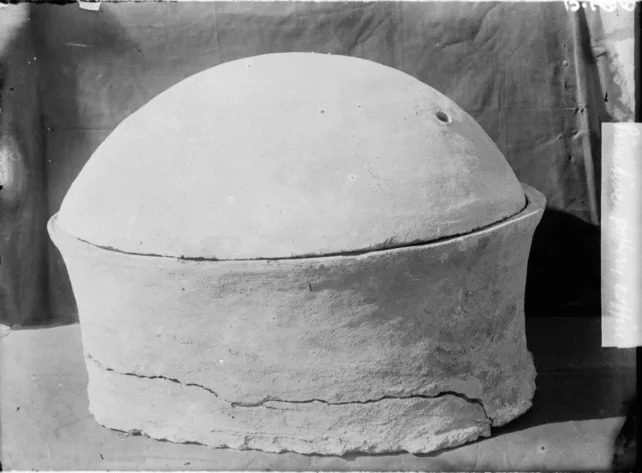For the very first time, scientists have sequenced DNA from the entire genome of an individual who lived in ancient Egypt up to 4,800 years ago – right when the first pyramids were being built.
The ancient genome belongs to an older male individual who was probably part of an elite social class and who, based on his ancestry, likely had brown hair, brown eyes, and dark skin.
About 80 percent of the man's genome is linked to lineages in North Africa, while the remaining 20 percent is linked to lineages in West Asia.
The findings suggest that early Egyptians once lived in a melting pot of cultures, with migrants and traders arriving from other parts of Africa and Mesopotamia – an ancient region that now encompasses parts of Iraq, Türkiye, and Iran.
 Geographic location of the Nuwayrat individual. (Morez Jacobs et al., Nature, 2025)
Geographic location of the Nuwayrat individual. (Morez Jacobs et al., Nature, 2025)Previous archaeological evidence has also indicated trade and cultural connections between Egypt and other parts of the Fertile Crescent, primarily through the exchange of domesticated plants and animals, writing systems, and technology such as the pottery wheel.
But actual human DNA is not as easily preserved in the hot and dry region. This newest discovery is the oldest DNA ever recovered from ancient Egypt, and scientists say the remains provide "direct evidence of genetic ancestry" from Mesopotamia.
"Ancient Egypt is a place of extraordinary written history and archaeology, but challenging DNA preservation has meant that no genomic record of ancestry in early Egypt has been available for comparison," says geneticist Pontus Skoglund, who founded the first high-throughput ancient DNA laboratory in the United Kingdom at the Francis Crick Institute.
"Building on this past research, new and powerful genetic techniques have allowed us to cross these technical boundaries and rule out contaminating DNA, providing the first genetic evidence for potential movements of people in Egypt at this time."
The ancient man's remains were recovered from a necropolis in the ancient city of Nuwayrat, 265 kilometers (165 miles) south of Cairo, where he was buried in a large pottery vessel inside a rock-cut tomb. He died sometime between 2855 and 2570 BCE.
 Pottery vessel in which the Nuwayrat individual was discovered. Reproduced courtesy of the Garstang Museum of Archaeology, University of Liverpool. (Morez Jacobs et al., Nature, 2025)
Pottery vessel in which the Nuwayrat individual was discovered. Reproduced courtesy of the Garstang Museum of Archaeology, University of Liverpool. (Morez Jacobs et al., Nature, 2025)In life, the individual was approximately 160 centimeters (5.2 feet) tall, and judging by his heavily worn teeth and severe arthritis, he was likely between 44 and 64 years old – an advanced age for the time.
His form of burial suggests he had a high social status, but unexpectedly, his body holds signs of routine physical labor.
"His seat bones are expanded in size, his arms showed evidence of extensive movement back and forth, and there's substantial arthritis in just the right foot. Though circumstantial, these clues point towards pottery, including use of a pottery wheel," suggests bioarchaeologist Joel Irish from Liverpool John Moores University.
"That said, his higher-class burial is not expected for a potter, who would not normally receive such treatment. Perhaps he was exceptionally skilled or successful to advance his social status."
When scientists analyzed the mix of isotopes in the ancient man's second molar, they found evidence that he grew up in the hot and dry Nile Valley, eating animal protein and plants like wheat and barley. This was typical for early Egyptians.
"This individual has been on an extraordinary journey. He lived and died during a critical period of change in ancient Egypt, and his skeleton was excavated in 1902 and donated to World Museum Liverpool, where it then survived bombings during the Blitz that destroyed most of the human remains in their collection," says archaeogeneticist Linus Girdland Flink from the University of Aberdeen.
"We've now been able to tell part of the individual's story."
One individual's story can't tell us everything we would like to know about ancient Egypt, but the findings are an intriguing start.
Researchers hope that their technique will allow for a "more detailed and nuanced understanding of ancient Egyptian civilization and its inhabitants" in the future.
The study was published in Nature.
Related News
Zapping Volunteers' Brains With Electricity Boosted Their Maths Skills
Ruins of Ancient Temple Belonged to Mysterious Pre-Inca Civilization
Does Using Artificial Intelligence Ruin Your Actual Intelligence? Scientists Investigated
This groundbreaking research into the oldest Egyptian DNA reveals insights that解锁了金字塔时代的精英陶工之秘, demonstrating how science is reconnecting us with our ancient history and providing a unique glimpse at life in pyramid times.
This remarkable discovery of the oldest Egyptian DNA reveals not only secrets from an advanced civilization's pyramids but also insights into ancient genetic practices and physiology, offering a never-before glimpse at elite potters during Egypt’ s chiseled times.














